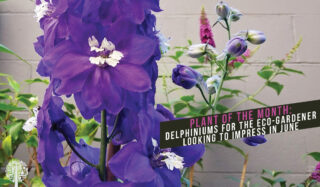Why Plant Delphiniums?
Delphiniums make a great backdrop or border in the June garden, especially when planted alongside foxgloves or the tall spikes of the nectar-rich hyssop. The neighborhood hummingbirds, bees, and butterflies will thank you for this gorgeous plant’s service to the garden’s ecosystem.
Delphinium Differences
Don’t confuse the spires of the perennial delphinium and the self-seeding bushy larkspur bearing the same moniker. The Royal Horticultural Society explains that perennial delphiniums are renowned for their rich colors and commanding presence. They flower in early summer. Meanwhile, easy-to-grow annual delphiniums (consolida or larkspur) are smaller self-seeding annuals that bloom all summer. Both provide equal service to the garden’s pollinators, but we focus on the perennial delphinium this month.

How to Grow Delphiniums
Delphiniums are hardy to at least -20°C and thrive during the cool nights and mornings of early summer. Plant this perennial beauty in a sunny spot in the garden with well-draining soil. They prefer early morning sun and late afternoon shade but are gracious and will adapt. A bit of a homebody, once delphiniums find a spot in the garden, they don’t like being uprooted and transplanted, so choose your location carefully. Delphiniums don’t like dry roots, but be careful not to overwater. Too much moisture can cause root rot.

Delphiniums will die back to the ground in the fall. Leave the dead, hollow stem on the plant or clip it and drop it on the ground. You will make a lovely winter home for some garden insects!
Growing Delphiniums in Containers
Container-grown delphiniums need special attention in the winter. Even if the pot has good drainage, it’s wise to pull it under cover in the fall and regulate its water intake. It’s so easy to overwater plants in the winter!
Pests and Disease
Slugs and garden snails are delphinium’s nemesis, especially in early spring as the new shoots break ground. I sprinkle garlic mixed with vinegar around the base. In humid climates, fungal issues such as powdery mildew, botrytis, and leaf spot are common. Ensuring the soil is not too wet and the leaves dry helps offset these issues.
Propagating Delphiniums
You can propagate delphiniums by dividing mature clumps, taking cuttings, or sowing seeds. However, all parts of delphiniums are poisonous, so wear gloves when handling plants and seeds.

Types of Delphiniums
Perennial delphiniums fall into three groups based on their looks:
- The Belladonna group has loosely branched flowers with side spikes that can reach 1-1.2m (3-4ft) high and 45cm (18″) wide.
- The Elatum group reaches 2m (over 6 feet!) high and flowers in early summer. If cut back after blossoming, they will flower again in early fall.
- Pacific hybrids are similar but slightly smaller, reaching 1.8m (6ft) and 75cm (30″) wide.
Delphiniums are commonly blue, but you can also find them in purple, pink, and white. As a gardener always looking for new and unusual plant varieties, I have to give a shout-out to Red Lark, a hybrid variety with all the same qualities as other perennial delphiniums but in red! It’s an excellent treat for the hummingbirds if you can find it.
See you next month as we garden and grow together!